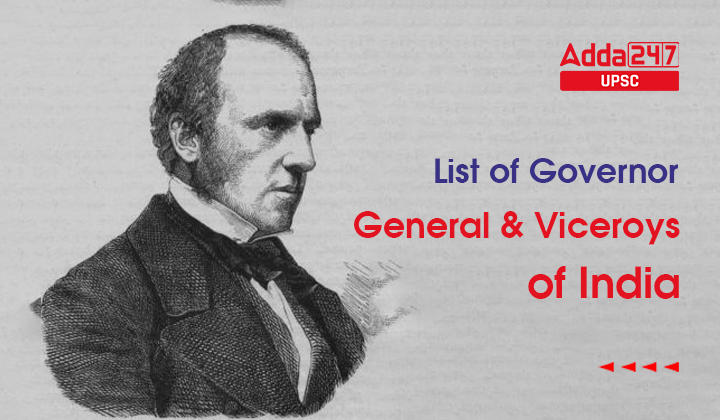Table of Contents
List of Governors-General and Viceroys of India: India was under British colonial rule for over 200 years, and during this period, it was governed by a series of Governors-General and Viceroys. The Governor-General was the chief administrator of British India and held wide-ranging powers to govern the country. The Viceroys, on the other hand, held the added duty of representing the British Crown in India and were chosen by the British Queen. These high-ranking officials’ roles and responsibilities altered throughout time, and eventually, their position became that of the Governor-General and Viceroy of India. Here is a list of some of the most notable individuals who served in this capacity during the British colonial period.
Governor General and Viceroys of India
Britain attained a global win and became one of the most powerful countries in the world. In India, the prevalent British rule was possible under the control of the Governor-General and viceroys. The British crown controlled the East India Company and divided territories into presidencies as their administrative units. There were three presidencies, Bengal, Madras, and Bombay controlled by a Governor respectively. The Governor-General has the highest responsibility of the administration.
The implementation of the British policies and maintaining their rule was done by the representative of the British Crown in India by the Viceroy of India. From 1857-1947, the Governor General of India was called the Viceroy of India. The title was a self-governing head of the government. Lord Canning was the first viceroy and the last viceroy of India was Lord Mountbatten in 1947.
Governor-General’s position was extremely important and highly prestigious being the supreme head of the administration during British rule. The Governor-General was the supreme representative of the British Crown in India for the administration. The Government of India Act of 1858 changed the position of Governor-General to Viceroy of India.
The title and position that was given before the Governor-General and Viceroy of India was Governor of Bengal. The title of Governor General of Bengal to Governor General of India was changed by The Regulating Act of 1833.
Governor-General of Bengal
The Governor-General of Bengal was a colonial administrative position created by the British East India Company in 1773. The position was established to consolidate the Company’s rule in India and to oversee its territorial possessions. The first person to hold the position was Warren Hastings, who served from 1773 to 1785. The Governor-General of Bengal was initially appointed by the East India Company and reported directly to its board of directors in London.
| Year/ Duration | Name | Events during tenure |
| 1772-1785 | Warren Hastings |
|
| 1786-1793 | Lord Cornwallis |
|
| 1793-1798 | Sir John Shore |
|
| 1798-1805 | Lord Wellesley |
|
| 1805-1807 | Sir George Barlow |
|
| 1807-1813 | Lord Minto I |
|
| 1813-1823 | Lord Hastings | · The end of policy of Non-intervention
|
| 1823-1828 | Lord Amherst |
|
Governor General of India
After gaining independence on August 15, 1947, India adopted a republican constitution, and the office of the Governor-General was replaced by the President of India. Dr. Rajendra Prasad became the first President of India on January 26, 1950, when the Indian Constitution came into effect. Check the name, year, and tenure of governor general of India.
| Year | Name of the Governor General | Major Events during the tenure |
| 1828-1835 | Lord William Bentinck |
|
| 1835-1836 | Lord Charles Metcalfe |
|
| 1836-1842 | Lord Auckland |
|
| 1842-1844 | Lord Ellenborough |
|
| 1844-1848 | Lord Hardinge I |
|
| 1848-1856 | Lord Dalhousie |
|
| 1856-1857 | Lord Canning |
|
List of Viceroys of India
The Viceroys of India were appointed by the British monarch to represent the Crown in India from 1858 to 1947. The position of Viceroy was created after the Indian Rebellion of 1857, which led to the British Crown taking over the administration of India from the East India Company. The first Viceroy was Lord Canning, who also served as the first Governor-General of India.
| Year | Name of Viceroy | Events during the tenure |
| 1856-1862 | Lord Canning |
|
| 1864-1869 | Lord John Lawrence |
|
| 1876-1880 | Lord Lytton |
|
| 1880-1884 | Lord Ripon |
|
| 1884-1888 | Lord Dufferin |
|
| 1888-1894 | Lord Lansdowne |
|
| 1899-1905 | Lord Curzon |
|
| 1905-1910 | Lord Minto II |
|
| 1910-1916 | Lord Hardinge II |
|
| 1916-1921 | Lord Chelmsford |
|
| 1921-1926 | Lord Reading |
|
| 1926-1931 | Lord Irwin |
|
| 1931-1936 | Lord Willingdon |
|
| 1936-1944 | Lord Linlithgow |
|
| 1944-1947 | Lord Wavell |
|
| 1947-1948 | Lord Mountbatten |
|
Governor-General and Viceroys of India UPSC
The first person to hold the position of Governor-General was Warren Hastings, who served from 1773 to 1785. C Rajgopalachari was the last Governor General of India and after him, the post was ended.
British government directly chose the Viceroy of India. The first viceroy of India was Lord Canning and the last was Lord Mountbatten. The Viceroy of India to represent the British took over the position of Governor General of India after 1858.



 TSPSC Group 1 Question Paper 2024, Downl...
TSPSC Group 1 Question Paper 2024, Downl...
 TSPSC Group 1 Answer key 2024 Out, Downl...
TSPSC Group 1 Answer key 2024 Out, Downl...
 UPSC Prelims 2024 Question Paper, Downlo...
UPSC Prelims 2024 Question Paper, Downlo...




